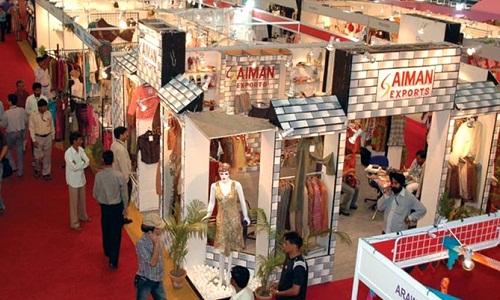FW
The Financial Commissioner Agriculture Production Department (APD), Pramod Jain says cocoon production registered an increase of 3 per cent. Thus it recorded a production of 973 metric tons in the current financial compared to last year’s 147 metric tons.
Under the Institute Village Linkage Program (IVLP), Central Sericulture Research and Training Institute (CSR&TI) has adopted 100 cocoon farmers in the vicinity of the institute at Pampore. The projects planned for development of the Silk Industry in the state with the support of Central Silk Board (CSB). Director of Sericulture, Malik Farooq informed that the department of sericulture has taken various initiatives for the uplift of this vital sector. The reason behind this is to see that the silk industry is developed on sustainable basis. He also informed that two separate projects for SC/ST families associated with the sericulture sector are in offing.
If US president-elect Donald Trump implements his plan of border tax, one of his major campaign promises, exports from Bangladesh, particularly of garment items, will face further tariff in the US market. Here, it may be recalled that during his 17-month presidential campaign, Trump had called for imposing border tax of between 35 and 45 per cent on imports of goods to protect American jobs from unfair foreign competition.
Ahsan H Mansur, Executive Director of the Policy Research Institute observed that if the proposed border tax is imposed, Bangladesh would be sufferers akin to other countries. The implementation of the proposed border tax would be the one of the worst news for the Asian country as well as for rest of the globe, he added.
Bangladesh's exports, particularly of garment items, would unequivocally be affected if Trump follows through on his campaign promise once he is sworn into office on January 20, according to Mansur. Although most of the attention is still focused on whether Trump will put the tariffs on China or target companies that move production offshore, proposals for a US tax regime that penalises imports could have a more permanent and far-reaching effect, it has been reported.
Frederic Neumann, co-head of economic research at HSBC in Hong Kong feels, it would be a huge issue for Asia. It would also raise the spectre of retaliatory measures by other countries. Since the US does not have adequate number of factories, local manufacturers might not meet the demand. As a result, the US retailers will depend on imported clothing items, particularly from Bangladesh and other Asian countries, which mainly produce the basic apparel items, Mansur claimed.
As per Textile Care, Fabric and Leather Technologies section of the VDMA (Association of German machinery and plant manufacturers), the German sewing and apparel technology industry has seen a 15.9 per cent increase in turnover compared to previous year January to October period. VDMA is the conceptual partner of Texprocess, the leading international textile fair held in Frankfurt.
With export sales of €523 million, Germany is in the third amongst exporting nations worldwide, behind China and Japan. M1ember companies are well placed amongst international competition. That is because they are continually developing and innovating.
"Championing Hong Kong designers is one of the most important pillars of Hong Kong Fashion Week (HKFW). This year Fashionally’ is presenting a two-part fashion show titled ‘Fashionally’ Collection #8’ and ‘Fashionally’ Collection #9,’ featuring Fall/Winter 2017 collections of 14 of the city’s most promising talents. Some of HK’s favourite designers will present captivating and inspired outfits on the catwalk, along with first-timers like Phenotypsetter, Yeung Chin, Kenson Tam, Winnie Witt and Ka Wa Key."

Championing Hong Kong designers is one of the most important pillars of Hong Kong Fashion Week (HKFW). This year Fashionally’ is presenting a two-part fashion show titled ‘Fashionally’ Collection #8’ and ‘Fashionally’ Collection #9,’ featuring Fall/Winter 2017 collections of 14 of the city’s most promising talents. Some of HK’s favourite designers will present captivating and inspired outfits on the catwalk, along with first-timers like Phenotypsetter, Yeung Chin, Kenson Tam, Winnie Witt and Ka Wa Key.
The first show Fashionally’ Collection #8 will focus on modern, updated women’s wear from design labels, including 112 mountainyam, Kevin Ho, FromClothingof, Lapeewee, Hang and Blind by JW. Contemporary reinterpretations of feminine aesthetics are lined up for ramp. The second show #9 showcases provocative and progressive designs that challenge the status quo from such design labels as Demo, Modement and Sherman Kwan. A look at some designers lined up for Fashionally’ Collection #8 and #9:
Mountain Yam: Kaleidoscopic Wonderland

He has a flair for mascu-feminine, psychedelic streetwear and isn’t afraid to experiment with graphic prints, which are evident in his latest collection, ‘Searching Self’. Expect deer-link motifs and a colourful burst of electric reds and blues with? The prints are offset by pieces in complete black to bring balance to the collection.
Shirley Wong: A liberation of beauty
Her latest collection ‘Beauty Undefined’ is based on the concept that women’s wear don’t have to be rigid and conform to a stereotypical feminine narrative. She wants to offer alternatives and choices for women who do not follow traditional standards.
Jane Ng: To the battlefront
Her collection, ‘Cloudy Swordsman,’ is a slight diversion from her usual aesthetic. Here she plays with volume and light, sheer materials that create an ethereal collection suited for those who want to take to the sky. A notable piece is her sleeved shirt styled with suspenders and a corset, and paired with a balloon skirt.
Kevin Ho: Surrealist drapery
His designs are typically recognisable by their distinct feminine cuts, silhouettes and patterns. For his latest collection, Suprematism, Ho returned to his roots with a display of contrasting fluid and structured elements using draping techniques against form-fitting cuts to create asymmetrical dresses made from different textures of wool, leather and silk. The result is a surreal and intriguing juxtaposition between structure and fluidity that’s bound to turn a few heads.
Yannes Wong & Stephanie Wong: Suited nomad
Lapeewee’s collections are all about taking a minimalistic approach to masculine, structured materials and treating it with feminine cuts and details. Their latest collection, ‘The Gypsy Wanderers,’ is no exception. The looks are reminiscent of Korean street-style and are for women who don’t want to be too girly.
Walter Kong & Jessica Lau: Blossoming winter
For A/W season, the duo has combined the lore of Sherlock Holmes with bold colours reminiscent of imperial China for a maximalist aesthetic. Blind by JW is all about going for more, and mixing various types of fabrics, textures, techniques and colours to create memorable statement pieces.
Mim Mak: Utilitarian construction
In her latest A/W17 collection, we can expect a stronger stance on utilitarian structure balanced by protruding, pleated details, along with striped and dotted embellishments inspired by the key pressure points of the human meridian. The colours of the pieces adhere to traditional earthy colours of olive and honey as well as stark black for easy, seasonal wear.
Aries Sin: Debonair gent
Modement typically adheres to a monochrome colour palette and juxtaposes fitted and loose pieces, which are also evident from her latest AW17 collection – ‘Concrete Jungle’. Here, Sin takes a romantic throwback to the 1950s, where men were fully layered in tailored suits with a matching vest, shirt and textured overcoat. To cope with the busy life and unrelenting concrete jungle of Hong Kong, Modement presents a strong silhouette with stark and serious colours.
Yeung Chin: Breaking the rules
Yeung’s designs are highlighted by a mixture of textures and unconventional choice of fabrics and use of trim. The geometric and sculptural elements to his designs are in full force in his latest collection. We can expect to see challenging proportions, asymmetrical silhouettes and bold, provocative outerwear.
Kenson Tam: Inner child
His collection is a continuation of his preppy, boyish narrative. You can expect dandy prints, a generous use of colour and mix of wool and knit textures. Tam’s designs are for men who aren’t afraid to show their inner child to the world.
Sherman Kwan: Femme fatale
She’s all about using black, black and more black in her clothing, oscillating between biker chic and utilitarian casual wear. For her upcoming collection, we can expect more dark and stark pieces with sharp cuts and a sleek silhouette.
Derek Chan: Schoolboy romance
For his latest collection, Chan continues a similar narrative to his brand. He’s showcasing his take on a 1950s prep school, giving a romantic twist to a prim and proper uniform. Expect to see bodysuits, breeches and tailored jackets with nostalgic schoolboy detailing.
Winnie Chen: Global domination
Chen’s brand reflects her edgy, global perspective in fashion and her latest collection, ‘Trinity’, focuses on three key philosophies that form her style foundation: geometry, space and body. Chen is a master in tailoring, which can be seen in her bold, architectural designs that offer a full-rounded, asymmetrical silhouette.
Key Chow: Redefining masculinity
It’s been a while since a designer has offered such a fresh outlook on menswear as Chow – filled with fairytale fantasy and using complex knit and lace fabrics to enhance the ‘twink’-like aesthetic he hopes to achieve.
"The 58th edition of India International Garment Fair (IIGF) is scheduled to be held from January 18 to 20 in New Delhi. The Fair, organised by the Apparel Export Promotion Council (AEPC) will cater to Autumn-Winter 2017-18. It is one of the largest and most popular platforms in Asia where domestic and overseas garment buyers source and forge business relationship with India’s finest in apparel and fashion accessories domain."

The 58th edition of India International Garment Fair (IIGF) is scheduled to be held from January 18 to 20 in New Delhi. The Fair, organised by the Apparel Export Promotion Council (AEPC) will cater to Autumn-Winter 2017-18. It is one of the largest and most popular platforms in Asia where domestic and overseas garment buyers source and forge business relationship with India’s finest in apparel and fashion accessories domain.
Power packed fair to showcase A/W 2017-18 collections The Fair would be inaugurated by Smriti Irani, Minister of Textile along with Ajay Tamta, Minister of State for Textiles, Rashmi Verma, Secretary (Textiles), and other officials. The 58th IIGF will have as many as 312 participants from 14 states including Delhi-NCR, Rajasthan, Maharashtra, Uttar Pradesh, West Bengal, Haryana, Tamil Nadu, Punjab, Gujarat, Karnataka etc. The 312 participants will be showcasing women’s wear, accessories, kid’s wear and menswear.

IIFG will also organize fashion shows twice a day on all three days for showcasing the collections for business development. Besides this, a theme pavilion, best display awards are some of the other attractions of the event. And as Ashok Rajani, Chairman AEPC says, “The 58th IIGF is India’s largest garment show in South Asia covering apparel and fashion accessories; encompassing a vast exhibition area. The objective is to showcase latest garment and fashion accessories trends shaping up and leverage brand India across the globe.”
The current market sentiments are not upbeat. Delays in roll out of apparel package and stagnation in EU and US markets have led to export stagnation as per export data of April-Dec 2016. Rajani is hopeful IIGF would serve as an effective platform for networking, influencing buyer sentiments and demonstrating our product strengths.
Started in in 1988, IIGF happens to be the only B2B fair conducting meaningful and quality business. Incorporated in 1978, AEPC is the official body of apparel exporters in India that provides invaluable assistance to Indian exporters as well as importers/ international buyers who choose India as their preferred sourcing destination for garments.
Continuing its collaborative efforts with Asahi Kasei, a diversified Japan-based manufacturer of fibres and chemicals, the Iluna Group, a leading producer of lingerie, lace, beachwear and bridal products has come out with a new line called Green Label. Green Label is a line that features lace, new double-needle bar lace and, for the very first time, fishnet stockings and jacquard aiming to represent creativity.
After a total switch last season that led the company to adopt the ROICA Eco Smart yarn by Asahi Kasei, a GRS-certified premium stretch yarn designed to ensure the recycling of production residues up to 60 per cent on all top-of-the-range Jacquardtronic and Textronic articles, the company has introduced Green Label, with the help of ROICA Eco Smart. ROICA Eco-Smart is an eco-friendly, stretch yarn with clear and certified environmental benefits that’s blended into many of this season’s new collections. This yarn uses more than 50 per cent pre- industrial waste material and is designed responsibly and ethically for customers looking to bring contemporary stretch to their own more sustainable product lines.
With Green Label, Iluna Group says it aims to become a leader in the production of lace on a global scale and offer a new typology of fully GRS-certified products. The Iluna Group was founded in 1969 based on an idea of Luigi Annovazzi, to produce pre-shaped bra cups. In 1985, Iluna acquired the Ondoli di Cuggiono plant, specialised in the production of elastic lace, challenging the French Leavers lace. The products, which constitute the core business of the group, are microfibre fabric and tulle, elastic and non-elastic lace for external apparel, underwear, corsetry and beachwear, hosiery, and articles without stitching, using Karl Mayer technology.
UniNet, the initial brand used by a Mexican telecommunications company named Telmex, will be exhibiting at the 2017 ISS Expo in Long Beach, Californai. The Expo, that will go on from January 20 to 22 will showcase iColor Printing Solutions. Here, UniNet will be demonstrating the iColor® 600 and 500 for the graphics, apparel and textile transfer markets.
The UniNet iColor 600 and 500 transfer printers are the most innovative toner-based digital printing technologies for short to mid-run production of apparel, garments, cards, stationary, invitations, envelopes, labels, brochures and more.
These printers feature full color, white and optional fluorescent toner colors that can be combined to create stunning transfer media output. The iColor 600 and 500 are the only printers on the market to feature white underprint and overprint capabilities, a groundbreaking new technology that enhances the vibrancy of text and graphics when printing on clear and dark media.
Joe Dovi, COO at UniNet said that his company will be offering a game-changing technology for the graphics, apparel and textile transfer markets with the most affordable toner-based, heat-transfer solution for full-color, fluorescent color and white printing on the market. The iColor 600 and 500 digital printers are an ideal complement to the graphic arts and textile transfer industries.
Shima Seiki Italia S.p.A., the Italy-based subsidiary of Japan-based computerized knitting machine manufacturer Shima Seiki will participate in the 80th edition of the Pitti Immagine Filati exhibition in Florence, Italy. The company will participate in the ‘Fashion At Work’ section of the exhibition that is aimed at appealing to the technical and creative interests of visitors by providing hardware and software solutions for design, manufacturing and processing of knitted goods.
On display will be Shima Seiki’s flagship Wholegarment knitting machine, Mach2xS. Featuring such innovations as the original SlideNeedle on four needle beds as well as the company’s patented spring-loaded moveable sinker system, Mach2xS can knit beautiful, high-quality 3-D items with dimensional structures and details that are uniquely Wholegarment, all with very high efficiency while minimizing dependence upon labor-intensive sewing and linking.
These qualities of Wholegarment knit production are maximized in combination with the SDS-One Apex3 3D design system, the latest version of which will be exhibited at Pitti Filati. At the core of the company’s Total Fashion System concept, Apex3 provides comprehensive support throughout the apparel supply chain, integrating production into one smooth and efficient workflow from yarn development, product planning and design to production and even sales promotion.
Especially effective is Apex3’s capability to improve on the design and evaluation process with ‘Virtual Sampling’. Ultra-realistic simulation capability on Apex3 allows Virtual Sampling to minimize the time- and cost-impact that the sample-making process has on current manufacturing. With this new manufacturing model, the production cycle can be shortened to such an extent that on-demand production can revolutionize the supply chain by freeing itself from seasonal cycles. Examples of knitwear produced on Shima Seiki’s latest line of computerized knitting machines will be on display as well, including Wholegarment knitwear as well as new proposals in knit-weave hybrid textiles produced on the SRY series machine.
Pakistan and Uzbekistan will explore joint opportunities in the textile sector. The trade volume between the two countries was $3.92 million in 2015-16, which increased from $2.98 million in 2014-15. Pakistan’s exports to Uzbekistan have witnessed a marginal increase, from $1.347 million in 2014-15 to $2.07 million in 2015-16, while imports from Uzbekistan have slightly increased from $1.56 million to $1.843 million during the same period.
However, bilateral trade between Pakistan and Uzbekistan is not reflective of the true potential. There are issues that hamper expansion of bilateral trade like lack of direct cargo links, safe and direct land routes, marketing strategies, knowledge of Pakistani products, visa facilitation and costly transportation by air.
Uzbekistan is a country of about 32 million people. Its major export commodities include cotton, textiles, energy products, gold, minerals, fertilisers, ferrous and nonferrous metals, foodstuffs, machinery, and automobiles. Major import commodities include machinery and equipment, foodstuffs, chemicals, ferrous and nonferrous metals.
Uzbekistan is one of the world’s largest producers and exporters of cotton. Traditional Uzbek textiles are taking the fashion world by storm. One of these is a fabric embroidered with silk threads, called suzani, and another is called ikat, which is woven with hand-spun silk yarn.
With a CAGR of 8.8 per cent between 2016-22, the global spandex market is expected touch $10,482 million by 2022 says the latest Spandex Fiber Market Report. Solution dry spinning segment would generate the highest revenue throughout the forecast period. In 2015, Asia-Pacific led the global market and is expected to maintain its position. The region is also expected to witness highest growth.
According to a senior analyst, Team Lead Chemical Research, Asia-Pacific is the most attractive market for the new entrants along with industry players as the growth in number of industries and increased expenditure towards R&D is expected to provide significant opportunities to the entrants. The industry players made significant investments on new commercial avenues for their product segments via strategic partnerships and collaborations.
Investments towards extensive research and development activities coupled with an increasing support for application of spandex fiber is expected to boost market growth. There is a rise in demand for spandex fiber from various end-user industries and an increase in application scope owing to its superior properties.
Also, launch of bio-based, eco-friendly spandex products by market players is expected to drive the demand for spandex fiber over the forecast period. However, a growing threat of substitution and volatility in raw material prices could hamper the market growth during the forecast period. In 2015, the apparel & clothing segment was the largest application segment. It is expected to grow at a CAGR of 8.9 per cent in terms of revenue, followed by the home furnishing and others segment. The extraordinary physio-chemical properties of spandex fiber such as elasticity, durability and abrasion resistance have increased its penetration in a wide array of application, as it results in improved performance of the end product.












